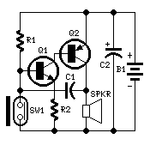geo_18
Newbie level 5
Dear friends,
I am thinking of doing the following circuit as one of my hobby circuits. Would you please help me to understand the working of the same??
I would like to know the use of the capacitors and transistors in this circuit...!
This circuit is a personal alarm against theft. When the switch becomes OPEN, the alarm would sound out loud. The alarm would be quiet when the switch is closed.
I have attached the circuit diagram below.
Here Q1 - BC547 and Q2 - BC 327.
R1 = 300k ohm, R2 = 100 ohm, C2 = 100 uF, C1 = 10nF. The battery used is 3Volts.

Waiting for your soon reply ....
I am thinking of doing the following circuit as one of my hobby circuits. Would you please help me to understand the working of the same??
I would like to know the use of the capacitors and transistors in this circuit...!
This circuit is a personal alarm against theft. When the switch becomes OPEN, the alarm would sound out loud. The alarm would be quiet when the switch is closed.
I have attached the circuit diagram below.
Here Q1 - BC547 and Q2 - BC 327.
R1 = 300k ohm, R2 = 100 ohm, C2 = 100 uF, C1 = 10nF. The battery used is 3Volts.

Waiting for your soon reply ....